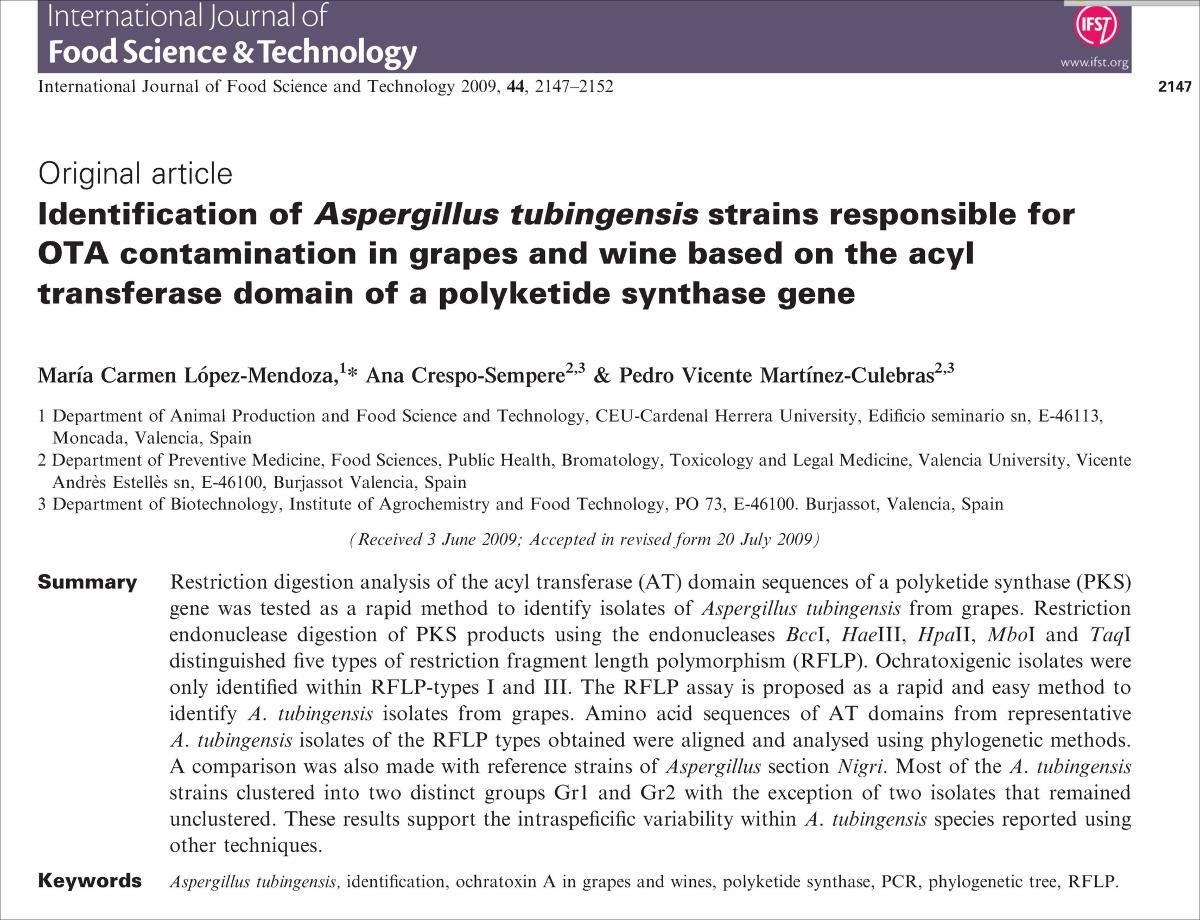Please use this identifier to cite or link to this item:
http://hdl.handle.net/10637/16293Identification of "Aspergillus tubingensis" strains responsible for OTA contamination in grapes and wine based on the acyl transferase domain of a polyketide synthase gene

See/Open:
Identification_Lopez_IJFST_2009.jpg
2,12 MB
JPEG
See/Open:
Identification_Lopez_IJFST_2009.pdf
Restricted Access
696,86 kB
Adobe PDF
Request a copy
| Title: | Identification of "Aspergillus tubingensis" strains responsible for OTA contamination in grapes and wine based on the acyl transferase domain of a polyketide synthase gene |
| Authors : | López Mendoza, María Carmen Crespo Sempere, Ana Martínez Culebras, Pedro Vicente |
| Keywords: | Vino; Wine; Uva; Grape; Biosíntesis; Biosynthesis; Aspergillus tubingensis; Ochratoxin A; Biología molecular; Molecular biology |
| Publisher: | John Wiley & Sons |
| Citation: | López Mendoza, M.C., Crespo Sempere, A., & Martínez Culebras, P.V. (2009). Identification of "Aspergillus tubingensis" strains responsible for OTA contamination in grapes and wine based on the acyl transferase domain of a polyketide synthase gene. International Journal of Food Science & Technology, 44(11), 2147 - 2152. https://doi.org/10.1111/j.1365-2621.2009.02053.x |
| Abstract: | Restriction digestion analysis of the acyl transferase (AT) domain sequences of a polyketide synthase (PKS) gene was tested as a rapid method to identify isolates of Aspergillus tubingensis from grapes. Restriction endonuclease digestion of PKS products using the endonucleases BccI, HaeIII, HpaII, MboI and TaqI distinguished five types of restriction fragment length polymorphism (RFLP). Ochratoxigenic isolates were only identified within RFLP-types I and III. The RFLP assay is proposed as a rapid and easy method to identify A. tubingensis isolates from grapes. Amino acid sequences of AT domains from representative A. tubingensis isolates of the RFLP types obtained were aligned and analysed using phylogenetic methods. A comparison was also made with reference strains of Aspergillus section Nigri. Most of the A. tubingensis strains clustered into two distinct groups Gr1 and Gr2 with the exception of two isolates that remained unclustered. These results support the intraspeficific variability within A. tubingensis species reported using other techniques. |
| Description: | Este recurso no está disponible en acceso abierto por política de la editorial. |
| URI: | http://hdl.handle.net/10637/16293 |
| Rights : | http://creativecommons.org/licenses/by-nc-nd/4.0/deed.es |
| ISSN: | 0950-5423 1365-2621 (Electrónico) |
| Issue Date: | Nov-2009 |
| Center : | Universidad Cardenal Herrera-CEU |
| Appears in Collections: | Dpto. Producción y Sanidad Animal, Salud Pública Veterinaria y Ciencia y Tecnología de los Alimentos |
Items in DSpace are protected by copyright, with all rights reserved, unless otherwise indicated.

